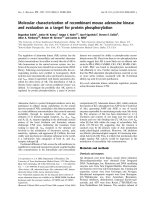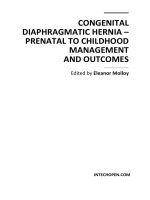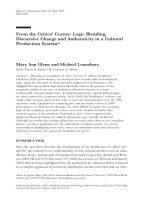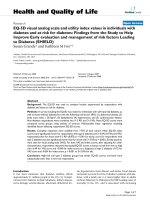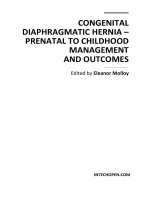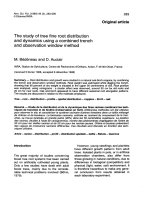Survival of outborns with congenital diaphragmatic hernia: The role of protective ventilation, early presentation and transport distance: A retrospective cohort study
Bạn đang xem bản rút gọn của tài liệu. Xem và tải ngay bản đầy đủ của tài liệu tại đây (789.54 KB, 8 trang )
Bojanić et al. BMC Pediatrics (2015) 15:155
DOI 10.1186/s12887-015-0473-x
RESEARCH ARTICLE
Open Access
Survival of outborns with congenital
diaphragmatic hernia: the role of protective
ventilation, early presentation and transport
distance: a retrospective cohort study
Katarina Bojanić1†, Ena Pritišanac2, Tomislav Luetić3, Jurica Vuković2, Juraj Sprung4, Toby N. Weingarten4*,
William A. Carey5, Darrell R. Schroeder6 and Ruža Grizelj2*†
Abstract
Background: Congenital diaphragmatic hernia (CDH) is a congenital malformation associated with life-threatening
pulmonary dysfunction and high neonatal mortality. Outcomes are improved with protective ventilation, less severe
pulmonary pathology, and the proximity of the treating center to the site of delivery. The major CDH treatment center
in Croatia lacks a maternity ward, thus all CDH patients are transferred from local Zagreb hospitals or remote areas
(outborns). In 2000 this center adopted protective ventilation for CDH management. In the present study we assess the
roles of protective ventilation, transport distance, and severity of pulmonary pathology on survival of neonates with CDH.
Methods: The study was divided into Epoch I, (1990–1999, traditional ventilation to achieve normocapnia), and Epoch II,
(2000–2014, protective ventilation with permissive hypercapnia). Patients were categorized by transfer distance (local
hospital or remote locations) and by acuity of respiratory distress after delivery (early presentation-occurring at birth, or
late presentation, ≥6 h after delivery). Survival between epochs, types of transfers, and acuity of presentation
were assessed. An additional analysis was assessed for the potential association between survival and end-capillary
blood CO2 (PcCO2), an indirect measure of pulmonary pathology.
Results: There were 83 neonates, 26 in Epoch I, and 57 in Epoch II. In Epoch I 11 patients (42 %) survived, and in Epoch
II 38 (67 %) (P = 0.039). Survival with early presentation (N = 63) was 48 % and with late presentation 95 % (P <0.001).
Among early presentation, survival was higher in Epoch II vs. Epoch I (57 % vs. 26 %, P = 0.031). From multiple logistic
regression analysis restricted to neonates with early presentation and adjusting for severity of disease, survival
was improved in Epoch II (OR 4.8, 95%CI 1.3–18.0, P = 0.019). Survival was unrelated to distance of transfer
but improved with lower partial pressure of PcCO2 on admission (OR 1.16, 95%CI 1.01–1.33 per 5 mmHg decrease,
P = 0.031).
Conclusions: The introduction of protective ventilation was associated with improved survival in neonates with
early presentation. Survival did not differ between local and remote transfers, but primarily depended on severity
of pulmonary pathology as inferred from admission capillary PcCO2.
Keywords: Acute lung injury, Comorbidity, Hernia, Diaphragmatic/epidemiology/mortality, Infant: newborn/
outborn status, Mechanical ventilation: pressure controlled/volume controlled, Risk assessment, Severity of illness
index: probability of survival score
* Correspondence: ;
†
Equal contributors
4
Department of Anesthesiology, Mayo Clinic, Rochester, MN 55902, USA
2
Department of Pediatrics, University of Zagreb, School of Medicine,
University Hospital Centre Zagreb, Zagreb, Croatia
Full list of author information is available at the end of the article
© 2015 Bojanić et al. Open Access This article is distributed under the terms of the Creative Commons Attribution 4.0
International License ( which permits unrestricted use, distribution, and
reproduction in any medium, provided you give appropriate credit to the original author(s) and the source, provide a link to
the Creative Commons license, and indicate if changes were made. The Creative Commons Public Domain Dedication waiver
( applies to the data made available in this article, unless otherwise stated.
Bojanić et al. BMC Pediatrics (2015) 15:155
Background
Congenital diaphragmatic hernia (CDH) is a congenital
malformation associated with life-threatening pulmonary
dysfunction and high neonatal mortality. In neonates
with CDH the presence of respiratory distress after
delivery indicates severe pulmonary involvement that
requires medical management which includes mechanical ventilatory support prior to undergoing surgical
correction [1].
The University Hospital Center (UHC) in Zagreb
Croatia is the national treatment center for neonates
with CDH. Before 2000, neonates with CDH cared for
at UHC underwent intermittent mandatory ventilation
(IMV) to achieve hyperventilation, a strategy based
on the premise that respiratory alkalosis may help control
degree of pulmonary hypertension [1–3]. However,
ventilation of hypoplastic lungs with high tidal volumes may induce volutrauma associated with intraalveolar hemorrhage and interstitial pulmonary edema
[4–6]. It was subsequently determined that protective
ventilation which uses the minimal pressure and volume settings to achieve acceptable oxygenation while
allowing for hypercapnia can reduce lung injury [7–11].
Therefore, in the year 2000 UHC adopted protective ventilation for neonates with CDH.
The UHC lacks a maternity ward, thus all neonates
with CDH are either transferred from local Zagreb
hospitals or remote areas in Croatia. This practice is
concerning because remote transfer of CDH neonates
may increase mortality [12]. The primary aim of this
study was to estimate the effects of the introduction
of protective ventilation on survival. A secondary aim
was to examine whether remote transfer, compared to
local transfer, impacted survival.
Methods
This study was approved by the Institutional Ethics
Committee of the University Hospital Centre (UHC),
Zagreb, Croatia. Due to retrospective design of this
study the written consent was waived by the UHC Institutional Ethics Committee.
Study design
A retrospective cohort study of neonates with CDH born
between January 1, 1990 and December 31, 2014 who
were treated at a single institution. The primary aim was
to assess whether the survival of neonates with CDH improved after the year 2000 with the introduction of protective ventilatory strategy. Since neonates with early
presentation are expected to have lower survival, the effects of protective ventilation both overall and in the
subset of neonates with early presentation was assessed.
The secondary aim was to explore the association between the type of transfer (local vs. remote) and
Page 2 of 8
survival. Because the time period covered by conventional
ventilatory strategies was characterized by a national conflict (Croatian War of Independence 1991–1995) and travelling was hampered, this association was explored
following the introduction of protective ventilation.
Study setting
The neonatal intensive care unit (NICU) of University
Hospital Center, Zagreb Croatia. The UHC is the national treatment center for neonates with CDH. UHC
lacks a maternity ward; therefore all subjects in this
study are outborns.
Definitions
Epoch I is the period between January 1, 1990 and
December 31, 1999, during which time hyperventilation with non-synchronized ventilation was used. Epoch II
is the period between January 1, 2000, and December 31,
2014, during which time a permissive hypercapnia using
protective ventilation was used. Outborn status refers to
infants born in another hospital requiring transport to
higher level of care. Patients were defined as “local
transfers” if they came from local Zagreb hospitals or
“remote transfers” from the rest of the country. Early
presentation is when respiratory distress is evident immediately after delivery requiring endotracheal intubation and mechanical ventilation. Late presentation, on
the other hand, is when the onset of breathing difficulties is delayed >6 h after delivery.
Management strategies
Epoch I
Neonates were sedated, paralyzed, and ventilated with
intermittent mandatory ventilation (IMV) to achieve respiratory alkalosis and postductal oxyhemoglobin saturation above 90 % to ameliorate pulmonary hypertension.
This strategy often required higher peak inspiratory
pressures (PIP), respiratory rates and oxygen concentrations. In those with available records of PIP, the
values were between 30 and 40 cmH2O.(new line and
header) Epoch II (new line) Ventilation was protocolized, and all neonates received protective ventilation
aimed to minimize volutrauma with the use of minimal pressure and volume settings and inspired oxygen
concentration to achieve acceptable preductal oxygenation
saturations (≥85 %) while permitting hypercapnia (≤65
mmHg). Only two modes of ventilation were used during
this time period: assist-control plus volume limit mode
(A/C + VL) and pressure support ventilation with volume
guarantee mode (PSV + VG). Both modes fully supported synchronized ventilation aided by controlled
“demand flow” circuitry which synchronizes inspiratory
gas delivery close to the breathing pattern of the neonate. Ventilatory settings were set per protocol. In the
Bojanić et al. BMC Pediatrics (2015) 15:155
A/C + VL mode the tidal volume limit was 6 mL/kg,
PEEP of 2–3 cm H2O, PIP ≤ 25 cmH2O, and the
backup respiratory rate 40 per min. If respiratory acidosis (obtained from preductal capillary blood) was
present (pH <7.25, PcCO2 >65 mmHg), ventilatory settings were changed by increasing PIP by 2 cmH2O
(until maximum PIP of 25 cmH2O was achieved). In
patients ventilated with PSV + VG mode the mean VG
used was 4.0 mL/kg (range 2.6–5.5 mL/kg), PEEP 3.8
(range 2.5–5) cm H2O, PIP ≤ 25 cmH2O, and backup
respiratory rate 40/min. If severe respiratory acidosis
was present, VG was increased to a maximum 5.5 mL/kg
exceeding the PIP limit if needed. With this strategy
sedation and muscle paralysis were infrequently used
and only in newborns with patient-ventilator asynchrony. High frequency oscillation ventilation (HFOV)
was a rescue treatment for neonates who continued to
have hypoxia and hypercarbia (PcCO2 >65 mmHg) despite optimization of either ventilatory mode. During
Epoch II inhaled nitric oxide (iNO) became available
and was used for neonates with ductal shunting (difference between preductal and postductal oxygen saturation >5 %), refractory preductal hypoxemia (PcO2 <60
mmHg with FiO2 >80 %), and for elevated right ventricular pressures. Surgical repair was typically done
following initial optimization of respiratory parameters.
Data collection
Patient variables that were abstracted included demographic information (date of birth, sex, place of birth
[local vs. remote transfers]); birth information (gestational age, birth weight, Apgar scores); CDH information
(prenatal diagnosis, acuity of presentation, pulmonary
hypertension, type of CDH, presence of peritoneal sac
and diaphragmatic aplasia), and physiologic variables
obtained early during hospitalization (admission preductal
capillary blood gases, lowest body temperature and lowest
mean blood pressure within 12 h of admission). Probability of survival (POS) was assessed from the equation
proposed by the Congenital Diaphragmatic Hernia
Study Group [13], to categorize neonates into 3 POS
score groups based on birth weight and 5-min Apgar
score: low (0 %–33 %), moderate (34 %–66 %), and high
(67 %–100 %) predicted survival groups. Variables regarding CDH management abstracted included mechanical ventilation mode; occurrence of preoperative
pneumothorax; use of iNO, surfactant, and/or vasoactive support; type of surgical repair (primary vs. nonprimary with patch); and time between delivery and
surgery. Survival to hospital discharge was noted.
Statistical analysis
Data are presented using mean ± SD or median
[25th, 75th percentile] for continuous variables, and
Page 3 of 8
frequency percentages for categorical variables. Characteristics were compared between groups using the
2- sample t-test, rank sum test, Chi square test, or
Fisher’s exact test. Logistic regression was used to assess whether hospital survival was associated with
epoch after adjusting for POS score. In order to
assess for trends in survival over time, before and
after the introduction of the protective ventilation,
logistic regression analyses was performed for each
time period with hospital survival as the dependent
variable and calendar year as the continuous explanatory variable. To explore the association between
local vs. remote transfer on survival we focused on
neonates with early presentation of symptoms during
Epoch II. Survival was compared using the Chi
square test. In all cases 2-tailed P values <0.05 were
considered statistically significant. Data were analyzed
using SAS version 9.3 (SAS Institute Inc, Cary, NC).
Results
Between January 1, 1990, and December 31, 2014,
there were 83 neonates who received formal intensive
care treatment, 26 were treated in Epoch I, and 57 in
Epoch II. Sixteen additional patients were excluded
for various reasons (see Fig. 1). All neonatal transfers
to our medical center were accomplished by ground
ambulance. Ventilation during transfer was accomplished via hand-held self-inflating bags for all neonates in Epoch I, and for the majority of neonates in
Epoch II. In Epoch II, 9 neonates, 1 local (survived)
and 8 remote (3 died) transfers, received ventilation
through a pressure controlled ventilator integrated in
transport incubator.
Table 1 summarizes demographic and disease characteristics of neonates with CDH. Table 2 summarizes
admission capillary blood gases and vital signs within
12 h of admission. Table 3 summarizes medical and
surgical interventions. During Epoch I all neonates received IMV, while in Epoch II protective ventilation
was utilized, including 8 patients who received rescue
HFOV. Surfactant and vasoactive support increased
and iNO became available during Epoch II.
Overall cohort survival
In Epoch I 11 of 26 patients (42 %) survived to discharge,
compared to 38 of 57 (67 %) in Epoch II (OR = 2.7, 95 %
CI 1.1 to 7.1, P = 0.039 for survival during Epoch II vs.
Epoch I). The percentage of patients who died after being
admitted without surgery was similar between Epochs I
and II, 27 % vs. 21 %, respectively (P = 0.815). Among
those who were discharged, length of stay did not differ
significantly between Epoch I vs. Epoch II (37 [19, 55] vs.
34 [23, 67] days; rank sum test P = 0.615). Calculated POS
score negatively correlated with admission end-capillary
Bojanić et al. BMC Pediatrics (2015) 15:155
Page 4 of 8
Fig. 1 Patients with congenital diaphragmatic hernia. Exclusions: other types of congenital diaphragmal hernia (n = 4): Morgagni hernia,
paraesophageal hernia, central hernia, severe diaphragmatic eventration. Lethal anomaly (n = 1) Edwards syndrome (trisomy 18) *Early presentation is
defined as respiratory distress immediately after birth requiring endotracheal intubation; †Late presentation is defined as respiratory distress
either absent or present >6 h after delivery
partial pressure of carbon dioxide, PcCO2 (r = −0.35,
P = 0.008). Survival was similar for patients who were
local vs. remote transfers, (53 % vs. 67 %, P = 0.216).
No temporal trends in survival were observed over
calendar time during Epoch I (P = 0.490) or Epoch II
(P = 0.373). From an analysis restricted to Epoch II,
there was no difference in survival between neonates
who were prenatally diagnosed with CDH compared
to those without prenatal diagnosis (P = 0.174).
Early vs. late presentation survival
Sixty-three neonates had early presentation and their
survival was worse compared to those with late presentation (48 % vs. 95 % survival, P <0.001). Among early
presentation neonates, survival was higher in Epoch II
vs. Epoch I (25 of 44, 57 % vs. 5 of 19, 26 %, OR 3.7 95 %
CI 1.1–12.0, P = 0.031). From multiple logistic regression analysis restricted to early presentation neonates
and adjusting for POS score, survival improved in
Epoch II compared to Epoch I (OR 4.8, 95 % CI 1.3–
18.0, P = 0.019). In an analysis restricted to neonates
with early presentation, no temporal trends were observed
over calendar time during Epoch I (P = 0.304) or Epoch
II (P = 0.777). Figure 2 shows hospital survival in neonates with early presentation of respiratory distress for
Epoch I and II according to expected survival based on
POS score. Within each expected survival category, observed survival was higher during Epoch II.
Bojanić et al. BMC Pediatrics (2015) 15:155
Page 5 of 8
Table 1 Demographic and disease characteristics in children with congenital diaphragmatic hernia (CDH)
Characteristic
Overall
Epoch I
Epoch II
(N = 83)
(N = 26)
(N = 57)
21 (25)
1 (4)
20 (35)
Male
52 (63)
16 (62)
36 (63)
Female
Prenatal diagnosis of CDHa
Sex
P-value
<0.001
0.888
31 (37)
10 (38)
21 (37)
Gestational age, weeks
38.6 ± 2.5
39.0 ± 2.0
38.4 ± 2.7
0.318
Birth weight, kg
3.1 ± 0.6
3.1 ± 0.6
3.1 ± 0.6
0.909
4 (5)
1 (4)
3 (5)
1.00
Apgar 1 minute
6.4 ± 2.8
7.1 ± 2.6
6.1 ± 2.9
0.129
Apgar 5 minute
6.5 ± 2.7
6.5 ± 2.8
6.5 ± 2.7
0.920
Early presentation
63 (76)
19 (73)
44 (77)
0.684
Local transfers
47 (57)
10 (38)
37 (65) b
0.024
Left
70 (84)
21 (81)
49 (86)
Right
12 (15)
5 (19)
7 (12)
Bilateral
1 (1)
0 (0)
1 (2)
Small for gestational age
b
CDH type
Probability of survival score (%)
0.661
0.63 ± 0.26
0.63 ± 0.24
0.63 ± 0.26
High (67–100)
43 (52)
14 (54)
29 (51)
Moderate (34–66)
29 (35)
9 (35)
20 (35)
Low (0–33)
11 (13)
3 (11)
8 (14)
13 (16)
4 (15)
9 (16)
Pneumothorax (preoperative)
Pulmonary hypertension
0.962
<0.001
Not assessed
20 (24)
20 (77)
0 (0)
Present
33 (40)
1 (4)
32 (56)
Absent
0.988
30 (36)
5 (19)
25 (44)
Diaphragmal aplasia
7 (8)
3 (11)
4 (7)
0.672
Peritoneal sac present
8 (10)
3 (11)
5 (9)
0.701
Data are N (%) or mean ± SD
a
All prenatally diagnosed CDH from remote areas were transferred to Zagreb, 1 in Epoch I, and 15 in Epoch II
b
Respiratory distress at birth
Local vs. remote transfer survival
During Epoch II, 44 neonates had early presentation, 31
were local, and 13 were remote transfers. All local
transfers, 31 of 31 (100 %), and 11 of 13 (85 %) remote
transfers were admitted within 24 h after delivery. Two
remote transfers arrived after 24 h from a distant
(280 km) hospital via ground ambulance. Of the remote transfers 9 (69 %) survived hospitalization compared to 16 (52 %) of local transfers (P = 0.282).
Birth characteristics did not differ between local and
Table 2 Admission capillary blood gases, lowest mean blood pressure and lowest temperature over the first 12 h after admission
Characteristic
Epoch I
P-Value
Epoch II
N
Mean ± SD
N
PcO2, mmHg
21
55.8 ± 25.0
57
Mean ± SD
52.3 ± 19.5
0.521
PcCO2, mmHg
20
57.3 ± 19.3
57
70.4 ± 30.9
0.080
pH
22
7.17 ± 0.19
54
7.16 ± 0.22
0.831
Base deficit, mEq/L
20
−5.82 ± 6.39
54
−5.95 ± 7.43
0.946
Lowest temperature, °C
19
36.3 ± 0.4
51
36.1 ± 0.6
0.228
Lowest mean blood pressure, mmHg
19
42.0 ± 7.6
56
38.4 ± 8.1
0.094
Abbreviation: PcCO2 partial pressure of carbon dioxide in the end-capillary blood
Bojanić et al. BMC Pediatrics (2015) 15:155
Page 6 of 8
Table 3 Interventions and type of surgical repair in neonates with congenital diaphragmatic hernia
Characteristic
Epoch I
Epoch II
(N = 26)
(N = 57)
Primary mechanical ventilation, n (%)
P-value
<0.001
Intermittent mandatory ventilation
26 (100)
0 (0)
Assist-control + volume limit mode
0 (0)
26 (45)
Pressure support + volume guarantee mode
0 (0)
31 (55)
High frequency oscillatory ventilationa
0 (0)
8 (15)
——
Inhaled nitric oxide
0 (0)
31 (54)
<0.001
Surfactant administration
1 (4)
16 (28)
<0.001
Vasoactive support
13 (50)
55 (96)
<0.001
Died before surgery
7 (27)
12 (21)
0.815
Time between delivery and surgery, hoursb
24.5 [24.7, 28.2]
29 [23.0, 29.0]
0.550
Type of surgical repair
19 (73)
45 (79)
0.815
Primary closure
18
39
Patch repair
1
5
Muscle flap repair
0
1
All values are N (%) or median [25th, 75th percentile]
a
Used only as a rescue technique
b
Although current practice shifted from emergent repair of CDH to a policy of preoperative medical stabilization using a variety of intensive care management
strategies, a recent Cochrane analysis showed that there was no clear evidence which favors delayed versus immediate (within 24 h of birth) surgical
intervention [29]
remote transfers, including gestational age (38.2 ± 2.7
vs. 38.4 ± 3.0 weeks, P = 0.900), birth weight (3.1 ± 0.7 vs.
2.9 ± 0.6 kg, P = 0.356), Apgar scores at 5 min (6.0 ± 2.2
vs. 4.9 ± 2.7, P = 0.193), and POS score (0.60 ± 0.23 vs.
0.46 ± 0.30, P = 0.113). However, on admission, local
transfers had lower pH (7.01 ± 0.19 vs. 7.26 ± 0.12, P
<0.001), lower base deficit (−9.8 ± 7.9 mq/L vs. -1.6 ± 4.1
mq/L, P = 0.001), and higher PcCO2 (87.5 ± 30.1 mmHg
vs. 59.8 ± 16.4 mmHg, P = 0.003) compared to remote
transfers. Also lowest mean blood pressure during the first
12 h after admission was significantly lower in local transfers (34.4 ± 7.2 mmHg vs. 41.2 ± 5.7 mmHg, P = 0.005) as
was the lowest body temperature (35.8 ± 0.7 °C vs. 36.5 ±
0.5 °C, P = 0.002). From a multivariable logistic regression
analysis that adjusted for PcCO2, survival was not found to
be significantly associated with the type of transfer (local
Fig. 2 Hospital survival in neonates with early presentation of respiratory distress for Epoch I and II according to expected survival (low, moderate and
high) based on calculated probability of survival score (see Methods). Within each risk stratification group there was a large increase in survival in Epoch II
Bojanić et al. BMC Pediatrics (2015) 15:155
vs. remote, P = 0.997). However, survival significantly improved with lower admission PcCO2 (OR 1.16, 95 % CI
1.01–1.33 per 5 mmHg decrease, P = 0.031).
Discussion
The main finding of this study is that protective ventilation for newborns with CDH was associated with
improvement in hospital survival, primarily due to a
substantial increase in survival among high-risk neonates. Despite higher acuity of CDH disease in local
neonates compared to remote transfers, the survival was
comparable, reflecting high level of care they have received. The level of admission capillary PcCO2 was an excellent marker for prognostication of survival.
The two most important management changes between epochs were the introduction of protective ventilation and iNO. While iNO is an effective method
to control pulmonary hypertension, its use may not reduce CDH mortality [14]. In contrast, ventilator-induced
lung injury may substantially increase mortality in neonates with hypoplastic lungs [3, 6–8, 10, 15] while protective ventilation improves survival, and may minimize the
need for extracorporeal membrane oxygenation (ECMO)
[11]. However, not all studies reported improvement in
survival with ECMO [6, 16], and neonatal ECMO was unavailable in Croatia during the study timeframe. In our
study the adoption of protective ventilation was associated
with a substantial improvement in survival for high-risk
neonates with respiratory distress occurring immediately
after delivery. Our overall survival in Epoch II was 67 %,
which is within the range reported by others [17–21].
However, the true CDH mortality is likely to be higher, as
this report does not include “hidden mortality”, i.e. newborns who died before they reached the neonatal unit [22,
23]. A large study reported that 35 % of live-born infants
died before being transported to the higher level of care
and the population of infants reaching tertiary surgical
centers represents approximately 40 % of the total number
of cases with CDH [24].
The effect of transport on survival in children with
CDH is difficult to assess because of multiple confounders
which may introduce patient selection bias. Some studies
report higher mortality for outborns (potential bias: more
severe cases were transferred and therefore less likely to
survive) [12, 25], while others describe lower mortality of
outborns (potential bias: transferred only less severe cases
and therefore more likely to survive) [26, 27]. In the
present study, there was no difference in survival between
local and remote transfers, but these findings also reflect
probable referral bias secondary to the availability of resources to transport high acuity neonates and transport
distance. We speculate that because of the difficulties in
long-distance transfers in Croatia (i.e., use of ground ambulance rather than helicopter) the transfer of CDH
Page 7 of 8
newborns from remote locations was reserved for less severe cases, introducing a potential bias towards improved
survival. This speculation is supported by our observation
that local neonates had more severe derangements in vital
signs and had more severe lung hypoplasia as inferred
from higher capillary PcCO2. Arterial PaCO2 is a good
marker for the degree of hypoplastic lung disease. Salas et
al. [28] demonstrated that PaCO2 >88 mmHg on admission (which was the mean PcCO2 of our local transfers)
was associated with low survival, while PaCO2 <66 mmHg
on admission (which was the mean PcCO2 of our remote
transfers) was a marker of improved survival. Our finding
of comparable survival between “sicker” local referrals and
remote transfers suggests that even the sickest neonates
who succeed to reach tertiary care may achieve substantial
survival. Since we encountered this imbalance of disease
severity between remote and local transfers, our study is
limited in drawing definitive conclusions regarding the effect of transport per se on survival in neonates with CDH.
Limitations
The limitation of our retrospective study is possibility for
presence of unforeseen confounders. Furthermore, the long
time span of the study may hide other unaccounted practice
changes that occur over calendar time. In order to examine
the effect of calendar time on outcomes additional analyses
were done that showed that hospital survival did not increase
or decrease over time within either epoch, and the improvement of survival after year 2000 suggests that improved survival can likely be attributed to protective ventilation.
Conclusions
With the introduction of protective ventilation, survival for
high-risk neonates with early respiratory distress substantially improved. Better survival was associated with lower
admission capillary PcCO2. Admission blood gases and vital
signs were substantially better in remote transfers indicating on potential referral bias related to transferring neonates with less severe disease. After adjusting for admission
PcCO2, survival did not differ significantly between local
and remote transfers. This suggests that being delivered
close to a tertiary care facility may be advantageous, especially for neonates with high disease acuity. Therefore,
mothers living in remote rural areas with less specialized
neonatal care should be considered for prenatal screening,
and if CDH is detected they should be referred for delivery
close to an institution with specialized neonatal care.
Abbreviations
A/C + VL: Assist-control ventilation with volume limit mode; CDH: Congenital
diaphragmatic hernia; ECMO: Extracorporeal membrane oxygenation;
HFOV: High frequency oscillation ventilation; IMV: Intermittent mandatory
ventilation; iNO: Inhaled nitric oxide; NICU: Neonatal intensive care unit;
PEEP: Positive end expiratory pressure; PIP: Peak inspiratory pressure;
POS: Probability of survival score; PSV + VG: Pressure support ventilation with
volume guarantee mode.
Bojanić et al. BMC Pediatrics (2015) 15:155
Competing interests
Authors declare no conflicts of interests.
Authors’ contributions
KB design, data collection, manuscript preparation, final proofing; JV design,
data collection, manuscript preparation; EP data collection, manuscript
preparation; TL collected information, manuscript preparation and final
proofing; TNW data analysis, manuscript preparation, final proofing; DRS,
statistics, manuscript preparation, manuscript proofing; WAC study design,
manuscript proofing; JS study design, data collection, manuscript preparation,
manuscript writing; RG study design, data collection, manuscript preparation.
All authors read and approved the final manuscript.
Authors' information
Not applicable.
Acknowledgements
Supported by the Department of Anesthesiology of Mayo Clinic in
Rochester, Minnesota, USA.
Author details
1
Division of Neonatology, Department of Obstetrics and Gynecology,
University Hospital Merkur, Zagreb, Croatia. 2Department of Pediatrics,
University of Zagreb, School of Medicine, University Hospital Centre Zagreb,
Zagreb, Croatia. 3Department of Pediatric Surgery, University of Zagreb,
School of Medicine, University Hospital Centre, Zagreb, Croatia. 4Department
of Anesthesiology, Mayo Clinic, Rochester, MN 55902, USA. 5Division of
Neonatal Medicine, Mayo Clinic, Rochester, MN, USA. 6Division of Biomedical
Statistics and Informatics, Mayo Clinic, Rochester, MN, USA.
Received: 29 May 2015 Accepted: 3 October 2015
References
1. Reynolds M, Luck SR, Lappen R. The “critical” neonate with diaphragmatic
hernia: a 21-year perspective. J Pediatr Surg. 1984;19:364–9.
2. Drummond WH, Gregory GA, Heymann MA, Phibbs RA. The independent
effects of hyperventilation, tolazoline, and dopamine on infants with
persistent pulmonary hypertension. J Pediatr. 1981;98:603–11.
3. Wung JT, James LS, Kilchevsky E, James E. Management of infants with
severe respiratory failure and persistence of the fetal circulation, without
hyperventilation. Pediatrics. 1985;76:488–94.
4. Price MR, Galantowicz ME, Stolar CJ. Congenital diaphragmatic hernia,
extracorporeal membrane oxygenation, and death: a spectrum of etiologies.
J Pediatr Surg. 1991;26:1023–6.
5. Sakurai Y, Azarow K, Cutz E, Messineo A, Pearl R, Bohn D. Pulmonary
barotrauma in congenital diaphragmatic hernia: a clinicopathological
correlation. J Pediatr Surg. 1999;34:1813–7.
6. Wilson JM, Lund DP, Lillehei CW, Vacanti JP. Congenital diaphragmatic
hernia–a tale of two cities: the Boston experience. J Pediatr Surg. 1997;32:401–5.
7. Boloker J, Bateman DA, Wung JT, Stolar CJ. Congenital diaphragmatic
hernia in 120 infants treated consecutively with permissive hypercapnea/
spontaneous respiration/elective repair. J Pediatr Surg. 2002;37:357–66.
8. Downard CD, Jaksic T, Garza JJ, Dzakovic A, Nemes L, Jennings RW, et al.
Analysis of an improved survival rate for congenital diaphragmatic hernia.
J Pediatr Surg. 2003;38:729–32.
9. Frenckner B, Ehren H, Granholm T, Linden V, Palmer K. Improved results in
patients who have congenital diaphragmatic hernia using preoperative
stabilization, extracorporeal membrane oxygenation, and delayed surgery.
J Pediatr Surg. 1997;32:1185–9.
10. Kays DW, Langham Jr MR, Ledbetter DJ, Talbert JL. Detrimental effects of
standard medical therapy in congenital diaphragmatic hernia. Ann Surg.
1999;230:340–8.
11. Wung JT, Sahni R, Moffitt ST, Lipsitz E, Stolar CJ. Congenital diaphragmatic
hernia: survival treated with very delayed surgery, spontaneous respiration,
and no chest tube. J Pediatr Surg. 1995;30:406–9.
12. Nasr A, Langer JC. Influence of location of delivery on outcome in neonates
with congenital diaphragmatic hernia. J Pediatr Surg. 2011;46:814–6.
13. Congenital Diaphragmatic Hernia Study Group. Estimating disease severity
of congenital diaphragmatic hernia in the first 5 minutes of life. J Pediatr
Surg. 2001;36:141–5.
Page 8 of 8
14. Clark RH, Kueser TJ, Walker MW, Southgate WM, Huckaby JL, Perez JA, et al. Lowdose nitric oxide therapy for persistent pulmonary hypertension of the newborn.
Clinical Inhaled Nitric Oxide Research Group. N Engl J Med. 2000;342:469–74.
15. Lally KP. Congenital diaphragmatic hernia. Curr Opin Pediatr. 2002;14:486–90.
16. Rozmiarek AJ, Qureshi FG, Cassidy L, Ford HR, Hackam DJ. Factors
influencing survival in newborns with congenital diaphragmatic hernia: the
relative role of timing of surgery. J Pediatr Surg. 2004;39:821–4.
17. Seetharamaiah R, Younger JG, Bartlett RH, Hirschl RB. Congenital
Diaphragmatic Hernia Study G. Factors associated with survival in infants
with congenital diaphragmatic hernia requiring extracorporeal membrane
oxygenation: a report from the Congenital Diaphragmatic Hernia Study
Group. J Pediatr Surg. 2009;44:1315–21.
18. Sola JE, Bronson SN, Cheung MC, Ordonez B, Neville HL, Koniaris LG.
Survival disparities in newborns with congenital diaphragmatic hernia:
a national perspective. J Pediatr Surg. 2010;45:1336–42.
19. van den Hout L, Reiss I, Felix JF, Hop WC, Lally PA, Lally KP, et al. Risk factors
for chronic lung disease and mortality in newborns with congenital
diaphragmatic hernia. Neonatology. 2010;98:370–80.
20. van den Hout L, Schaible T, Cohen-Overbeek TE, Hop W, Siemer J, van de
Ven K, et al. Actual outcome in infants with congenital diaphragmatic
hernia: the role of a standardized postnatal treatment protocol. Fetal Diagn
Ther. 2011;29:55–63.
21. Wright JC, Budd JL, Field DJ, Draper ES. Epidemiology and outcome of
congenital diaphragmatic hernia: a 9-year experience. Paediatr Perinat Ep.
2011;25:144–9.
22. Harrison MR, Bjordal RI, Langmark F, Knutrud O. Congenital diaphragmatic
hernia: the hidden mortality. J Pediatr Surg. 1978;13:227–30.
23. Brownlee EM, Howatson AG, Davis CF, Sabharwal AJ. The hidden mortality of
congenital diaphragmatic hernia: a 20-year review. J Pediatr Surg. 2009;44:317–20.
24. Colvin J, Bower C, Dickinson JE, Sokol J. Outcomes of congenital
diaphragmatic hernia: a population-based study in Western Australia.
Pediatrics. 2005;116:e356–63.
25. Aly H, Bianco-Batlles D, Mohamed MA, Hammad TA. Mortality in infants
with congenital diaphragmatic hernia: a study of the United States National
Database. J Perinatol. 2010;30:553–7.
26. Khmour AY, Konduri GG, Sato TT, Uhing MR, Basir MA. Role of admission
gas exchange measurement in predicting congenital diaphragmatic hernia
survival in the era of gentle ventilation. J Pediatr Surg. 2014;49:1197–201.
27. Migliazza L, Bellan C, Alberti D, Auriemma A, Burgio G, Locatelli G, et al.
Retrospective study of 111 cases of congenital diaphragmatic hernia treated
with early high-frequency oscillatory ventilation and presurgical stabilization.
J Pediatr Surg. 2007;42:1526–32.
28. Salas AA, Bhat R, Dabrowska K, Leadford A, Anderson S, Harmon CM, et al.
The value of Pa(CO2) in relation to outcome in congenital diaphragmatic
hernia. Am J Perinatol. 2014;31:939–46.
29. Moyer V, Moya F, Tibboel R, Losty P, Nagaya M, Lally KP. Late versus early
surgical correction for congenital diaphragmatic hernia in newborn infants.
Cochrane Database of Systematic Reviews 2000, Issue 4. Art. No.: CD001695.
doi: 10.1002/14651858.CD001695.
Submit your next manuscript to BioMed Central
and take full advantage of:
• Convenient online submission
• Thorough peer review
• No space constraints or color figure charges
• Immediate publication on acceptance
• Inclusion in PubMed, CAS, Scopus and Google Scholar
• Research which is freely available for redistribution
Submit your manuscript at
www.biomedcentral.com/submit

